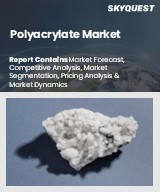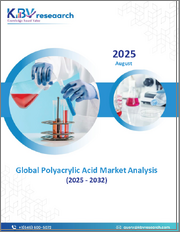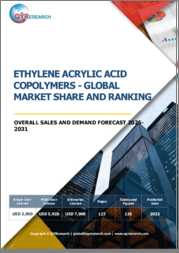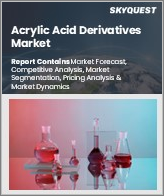
|
시장보고서
상품코드
1771396
세계의 아크릴산 시장 분석 : 수요, 용도별, 예측 분석(2034년)Acrylic Acid Market Analysis, By Demand, By Applications [Baby Diapers and Personal Care Products] & Forecast Analysis, 2034 |
||||||
2024년 세계 아크릴산 시장 규모는 139억 달러 이상이며, 2034년까지 연평균 6%의 성장률로 230억 달러를 넘어설 것으로 예측됩니다. 이러한 성장의 주요 요인은 페인트 및 코팅, 개인 위생 제품, 수처리 용도에 대한 수요 증가 등입니다. 개발도상국에서는 가처분 소득 증가와 도시화로 인해 아크릴산 유도체에 의존하는 소비재 소비가 증가하고 있습니다. 성숙 시장에서는 기술 혁신과 지속가능성 추세가 주요 성장 요인으로 작용하고 있습니다.
세계 아크릴산 시장은 다양한 산업적 용도로 인해 지속적인 성장세를 보이고 있습니다. 아크릴산은 다양한 유도체, 특히 아크릴산 에스테르와 SAP를 생산할 때 기초 화학물질로서 중요한 역할을 합니다. 이러한 유도체는 페인트, 접착제, 섬유, 아기 기저귀 및 성인용 요실금 제품과 같은 위생용품, 수처리 및 세제와 같은 부문의 제품에 없어서는 안 될 성분입니다. 퍼스널케어 및 지속가능한 솔루션에 대한 수요가 증가함에 따라 선진국과 개발도상국 모두에서 시장이 지속적으로 확대되고 있습니다.
지역 시장 동향
세계 아크릴산 시장은 생산과 소비량면에서 아시아태평양이 우위를 점하고 있습니다. 중국과 인도와 같은 국가들은 빠른 산업 성장, 소비 지출 증가, 위생에 대한 인식이 높아짐에 따라 주도하고 있습니다. 중국은 혼자서 이 지역의 생산 능력과 수요의 대부분을 차지하고 있습니다. 인도는 현재 순 수입국이지만 최근 Bharat Petroleum과 Indian Oil이 아크릴산 공장을 설립함에 따라 주요 생산국이 될 것으로 예측됩니다. 북미와 유럽과 같은 선진 지역에서는 특히 코팅과 접착제 분야에서 안정적인 수요가 지속되고 있습니다. 이들 시장도 엄격한 규제 프레임워크에 따라 바이오 및 친환경 제품으로 전환하고 있습니다. 라틴아메리카와 중동은 유망한 시장으로 부상하고 있으며, 아크릴 유래 재료의 채택을 점차 늘리고 있습니다.
생산 능력 및 공급 역학
세계 아크릴산 생산 능력은 2020년 8,500 킬로톤에서 2024년 9,500 킬로톤을 넘었습니다. 이러한 성장의 대부분은 아시아태평양, 특히 중국에서 대규모 생산능력 증설이 이루어지고 있으며, BASF SE는 미국, 중국, 독일, 말레이시아를 포함한 여러 국가에 시설을 보유하고 세계 생산능력의 17%를 차지하며 선두를 달리고 있으며, Nippon Shokubai가 2위, LG Chem과 Dow Chemicals가 그 뒤를 잇고 있습니다. LG Chem과 Dow Chemicals가 그 뒤를 잇고 있습니다. 기타 주요 기업에는 Evonik Industries, Arkema SA, Sasol Ltd, Mitsubishi Chemical Holdings, Hexion Incorporated 등이 있습니다. 인도에서는 Bharat Petroleum과 Indian Oil Corporation이 특히 최근 대규모 아크릴산 생산 공장에 대한 투자로 인해 중요한 기여자로 부상하고 있습니다.
시장 성장 촉진요인과 억제요인
시장 성장의 주요 촉진요인 중 하나는 전 세계에서 퍼스널케어 및 위생 제품에 대한 수요 증가입니다. 기저귀나 생리대와 같은 제품에 필수적인 고흡수성 폴리머는 특히 고령화 및 중산층이 증가하는 지역에서 높은 수요를 보이고 있습니다. 더 얇고, 더 높은 흡수력을 가진 소재 등 SAP 기술의 발전으로 인해 더욱 확산되고 있습니다.
시장은 또한 주목할 만한 문제에 직면해 있습니다. 아크릴산은 휘발성 유기화합물(VOC)이며, 생산에 프로파일렌과 같은 석유 유래 원료가 사용되므로 지속가능성과 환경에 대한 우려가 커지고 있습니다. 북미와 유럽에서는 배출가스 및 안전에 대한 규제가 엄격해지고, 컴플라이언스 비용이 증가함에 따라 기업은 바이오 아크릴산과 같은 친환경 대안을 모색하고 있습니다. 특히 ADM, LG화학, Cargill과 같은 기업이 재생한 원료 기술의 상용화를 위해 공동연구를 진행하면서 이러한 대체품이 더욱 탄력을 받고 있습니다.
세계의 아크릴산 시장에 대해 조사분석했으며, 시장 역학과 산업 동향, 각 부문의 수요, 제조업체 개요 등의 정보를 제공하고 있습니다.
목차
제1장 서론
제2장 시장 요약
- 시장의 진화
- 수급 개요
- 산업 구조
- 전략상 문제
- 최종 용도 동향
- 성장 예측
제3장 경제와 에너지 전망
- GDP와 인구통계
- 금융정책과 재정정책
- 원유생산과 가격
- 천연가스
- 전기요금
제4장 최종 용도 부문 실적
- 종이
- 텍스타일
- 화학
- 수처리
- 기타
제5장 생산능력(플랜트와 프로젝트) 분석
- 생산능력 : 기업별
- 생산능력 : 국가/지역별
- 생산능력 개요 : 지역/국가별
제6장 아크릴산의 서론과 시장 개요
- 제품 설명
- 등급과 특성
- 원재료
- 제조 프로세스
- 환경 문제
- 밸류체인
- 용도
제7장 시장 역학과 산업 동향
- 시장 역학
- 촉진요인
- 억제요인
- 기회
- 과제
제8장 세계의 아크릴산 수급 분석 : 파생품별(수량과 금액)(2018-2034년)
- 전략상 문제
- 수급 분석과 예측(2018-2034년)
- 생산능력
- 가동률
- 생산
- 수입
- 수출
- 순수출
- 수요
- 수요 성장률
- 촉진요인 분석
- 세계의 아크릴산 시장 : 파생품별
- 범용 아크릴레이트
- 폴리아크릴산
- 고흡수성 폴리머
- 수처리
- 세제 코빌더
- 기타
제9장 수급 분석과 시장 리뷰 : 지역/국가별(수량과 금액)(2018-2034년)
- 전략상 문제
- 생산능력
- 가동률
- 생산
- 수입
- 수출
- 순수출
- 수요
- 수요 성장률
- 아크릴산 시장 : 파생품별
- 북미
- 미국
- 캐나다
- 멕시코
- 서유럽
- 독일
- 프랑스
- 이탈리아
- 영국
- 스페인
- 기타 서유럽
- 중유럽·동유럽
- 러시아
- 폴란드
- 기타 중유럽·동유럽
- 아시아태평양
- 중국
- 일본
- 인도
- 한국
- 기타 아시아태평양
- 중남미
- 중동 및 아프리카
제10장 가격 분석
- 아크릴산의 평균 가격
- 평균 가격 : 지역별
- 가격 예측
제11장 주요 전략상 문제
제12장 기회 평가
- 시장의 매력 평가
- 전망과 타겟 시장 조사
제13장 전략적 추천과 제안
제14장 기업 분석
- 아크릴산 제조업체 개요/기업 분석
- 기본 상세
- 본사, 주요 시장
- 소유
- 기업의 재무
- 제조 기반
- 세계의 매출액
- 총직원 수
- 제품 포트폴리오/서비스/솔루션
- 채택된 주요 사업 전략과 Prismane Consulting 개요
- 최근 발전
- 대상 기업
- BASF SE
- Nippon Shokubai Co.Ltd.
- Evonik Industries
- LG Chem Ltd.
- Arkema SA
- Dow Chemicals
- PJSC Sibur Holding
- Sasol Ltd
- Mitsubishi Chemicals Holding Corporation
- Hexion Incorporated
- 기타 제조업체
제15장 부록
KSA 25.07.25In 2024, the global acrylic acid market was valued at above USD 13.9 billion with a projected CAGR of 6%, the market is further anticipated to reach over USD 23 billion by 2034. The key factors behind this growth include increasing demand for paints and coatings, personal hygiene products, and water treatment applications. In developing countries, rising disposable incomes and urbanization are boosting the consumption of consumer goods that rely on acrylic acid derivatives. In mature markets, technological innovation and sustainability trends are key growth enablers.
The global acrylic acid market is experiencing consistent growth, driven by its wide range of industrial applications. Acrylic acid plays a crucial role as a base chemical in the production of various derivatives, particularly acrylates and SAPs. These derivatives are essential components in products like paints, adhesives, textiles, hygiene items such as baby diapers and adult incontinence products, and in sectors such as water treatment and detergents. With rising demand for personal care and sustainable solutions, the market continues to expand across both developed and developing economies.
Acrylic Acid Demand Analysis
Acrylic acid is used to manufacture commodity acrylates such as methyl acrylate, butyl acrylate, ethyl acrylate, and 2-ethylhexyl acrylate and these chemicals are integral in producing coatings, adhesives, sealants, textiles, and plastics. Glacial acrylic acid is specifically important for making superabsorbent polymers used in personal hygiene products. Its strong absorbent capacity makes it ideal for diapers and sanitary products. Moreover, its derivatives are valued in the water treatment and detergent industries for their ability to disperse particles and prevent scaling. This broad spectrum of uses ensures continued demand from various end-user industries like paper, textiles, and chemicals.
Regional Market Trends
Asia-Pacific dominates the global acrylic acid market in terms of both production and consumption. Countries like China and India are leading due to rapid industrial growth, increased consumer spending, and rising hygiene awareness. China alone accounts for a major share of regional capacity and demand. India, although currently a net importer, is on track to become a major producer following the recent establishment of acrylic acid plants by Bharat Petroleum and Indian Oil. In developed regions such as North America and Europe, demand remains stable, particularly in coatings and adhesives. These markets are also shifting toward bio-based and environmentally friendly products due to strict regulatory frameworks. Latin America and the Middle East are emerging as promising markets, gradually increasing their adoption of acrylic-based materials.
Production Capacity and Supply Dynamics
The global acrylic acid production capacity exceeded 9,500 kilotons in 2024, up from 8,500 kilotons in 2020. Most of this growth occurred in Asia-Pacific, particularly China, where large-scale capacity additions have been made. BASF SE holds a leading position, accounting for 17% of the global capacity, with facilities in multiple countries including the U.S., China, Germany, and Malaysia. Nippon Shokubai is the second-largest producer, followed by LG Chem and Dow Chemicals. Other significant players include Evonik Industries, Arkema SA, Sasol Ltd, Mitsubishi Chemical Holdings, and Hexion Incorporated. In India, Bharat Petroleum and Indian Oil Corporation are emerging as important contributors, especially with their recent investments in large-scale acrylic acid production plants.
India is becoming a significant player in the acrylic acid market. With a CAGR forecast of nearly 11% through 2034, the country is poised to experience rapid demand growth. This is largely driven by its expanding hygiene product market, rising construction activities, and overall economic growth. India's shift from being a net importer to a self-reliant and potentially exporting nation is supported by capacity expansions from state-owned companies and partnerships with global players like BASF and the Adani Group. The Indian government's support for local manufacturing and infrastructure also provides a favorable environment for the acrylic acid industry.
Recent Developments and Sustainability Trends
The industry is moving toward more sustainable practices, with several initiatives to develop and commercialize bio-based acrylic acid. In May 2023, Nippon Shokubai opened a new plant in Indonesia, increasing its capacity significantly. Meanwhile, companies like Cargill and Procter & Gamble are working on bio-based alternatives using renewable sources like corn dextrose. Although early attempts faced setbacks, renewed efforts are underway to meet rising sustainability demands and reduce carbon footprints. These innovations are expected to become increasingly important as global markets adopt stricter environmental standards and consumers prioritize eco-friendly products.
Market Drivers and Restraints
One of the primary drivers of market growth is the rising demand for personal care and hygiene products globally. Superabsorbent polymers, which are essential for products like diapers and sanitary napkins, are witnessing strong demand especially in regions with aging populations or growing middle classes. Advancements in SAP technology, such as thinner materials with higher absorbency, are pushing further adoption.
The market also faces notable challenges. Acrylic acid is a volatile organic compound (VOC), and its production involves the use of petroleum-based feedstocks like propylene, raising sustainability and environmental concerns. Strict regulations in North America and Europe regarding emissions and safety have increased compliance costs and are prompting companies to explore greener alternatives such as bio-based acrylic acid. These alternatives are gaining traction, especially with collaborations between companies like ADM, LG Chem, and Cargill aiming to commercialize renewable feedstock technologies.
Table of Contents
1. Introduction
- Scope
- Market Coverage
- Derivatives
- Regions
- Countries
- Years Considered
- Historical - 2018 - 2023
- Base - 2024
- Forecast Period - 2025 - 2034
- Research Methodology
- Approach
- Research Methodology
- Prismane Consulting Market Models
- Assumptions & Limitations
- Abbreviations & Definitions
- Conversion Factors
- Data Sources
2. Market Synopsis
- Market Evolution
- Demand-Supply Overview
- Industry Structure
- Strategic Issues
- End-use Trends
- Growth Forecast
3. Economic & Energy Outlook
- GDP and Demographics
- Monetary & Fiscal Policies
- Crude Oil Production and prices
- Natural Gas
- Electricity Prices
4. End-use Sector Performance
- Paper
- Textile
- Chemical
- Water Treatment
- Others
5. Capacity (Plants & Projects) Analysis
- Capacity, by Company
- Capacity, by Country and by region
- Capacity Overview, By Region and Country
6. Introduction to Acrylic Acid and Market Overview
- Product Description
- Grades & Properties
- Raw Material
- Manufacturing Process
Propylene Oxidation
Acrylonitrile Hydrolysis
REPPE Process
Bio-based Acrylic Acid Process
- Environmental Issues
- Value Chain
- Applications
7. Market Dynamics and Industry Trends
- Market Dynamics
- Drivers
- Restraints
- Opportunities
- Challenges
8. Global Acrylic Acid Demand-Supply Analysis, By Derivatives (Volume, Value) (2018-2034)
- Strategic Issues
- Demand-Supply Analysis and Forecast (2018- 2034)
- Capacity
- Capacity Utilization (%)
- Production
- Imports
- Exports
- Net Trade
- Demand
- Demand Growth Rate (%)
- Driving Force Analysis
- Global Acrylic Acid Market, By Derivatives
- Commodity Acrylates
Methyl Acrylate
Ethyl Acrylate
Butyl Acrylate
2-Ethylhexyl Acrylate
Others
- Poly Acrylic Acid
- Superabsorbent polymers
- Water treatment
- Detergent co-builders
- Others
9. Demand-Supply Analysis and Market Review, By Region, By Country (Volume, Value), (2018- 2034)
- Strategic Issues
- Capacity
- Capacity Utilization (%)
- Production
- Imports
- Exports
- Net Exports
- Demand
- Demand Growth Rate (%)
- Acrylic Acid Market, By Derivatives
Note: Demand-Supply Analysis has been provided for all major Regions / Countries as mentioned below. The demand (consumption) split by derivatives has been provided for each of the countries/regions in Volume (Kilo tons) and Value (USD Million).
- North America
- USA
- Canada
- Mexico
- Western Europe
- Germany
- France
- Italy
- United Kingdom
- Spain
- Rest of Western Europe
- Central & Eastern Europe
- Russia
- Poland
- Rest of Central & Eastern Europe
- Asia-Pacific
- China
- Japan
- India
- South Korea
- Rest of Asia-Pacific
- Central & South America
- Middle East & Africa
Note: CAGR will be calculated for all derivatives to arrive at the regional / global Demand-Supply growth for the forecast period (2025 - 2034)
10. Pricing Analysis
- Average Acrylic Acid Prices, USD/Kg
- Average prices, by region
- Price Forecast
11. Key Strategic Issues
12. Business Opportunity Assessment
- Market Attractiveness Assessment
- Prospective & Target Market Study
13. Strategic Recommendation & Suggestions
14. Company Analysis
- Acrylic Acid Manufacturers Profiles/ Company Analysis
- Basic Details
- Headquarter, Key Markets
- Ownership
- Company Financial
- Manufacturing Bases
- Global Turnover
- Total Employee
- Product Portfolio / Services / Solutions
- Key Business Strategies adopted and Prismane Consulting Overview
- Recent Developments
- Companies Covered -
- BASF SE
- Nippon Shokubai Co.Ltd.
- Evonik Industries
- LG Chem Ltd.
- Arkema SA
- Dow Chemicals
- PJSC Sibur Holding
- Sasol Ltd
- Mitsubishi Chemicals Holding Corporation
- Hexion Incorporated
- Other Manufacturers
Note: This section includes company information, company financials, manufacturing bases and operating regions. Company financials have been mentioned only for those companies where financials were available in SEC Filings, annual reports, or company websites. All the reported financials in this report are in U.S. Dollars. Financials reported in other currencies have been converted using average currency conversion rates. Company profiles may include manufacturers, suppliers, and distributors.
15. Appendices
- Demand-Supply - Regions
- Demand-Supply - Countries
- Capacities, 2018-2034



















